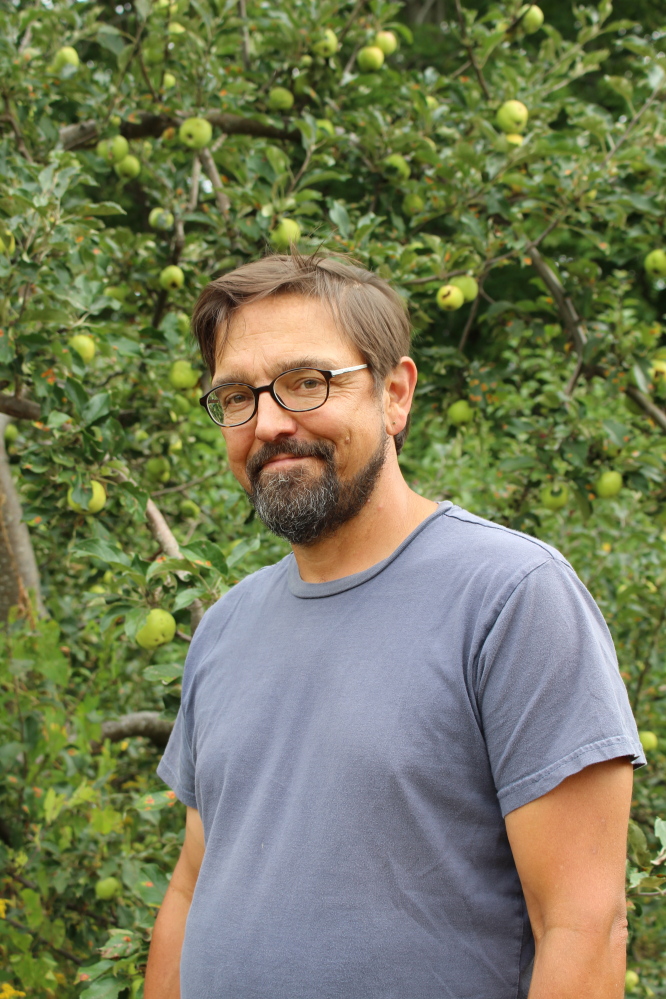Todd Little-Siebold of Ellsworth is on a quest to discover lost Maine treasure.
A history professor at College of the Atlantic in Bar Harbor, Little-Siebold, 53, has spent the past eight years trying to find abandoned apple orchards in Maine to rediscover heirloom apple varieties long absent from state produce records.
The work pairs Little-Siebold’s expertise in Latin-American agrarian studies with his knowledge of apple varieties in Maine.
While researching the state’s agricultural history, Little-Siebold learned that in the mid-1800s Maine had a thriving export business that annually shipped about 1.5 million barrels of apples to England. As a result, many Mainers began to plant orchards as a means of income.
“For instance, in 1850 Ellsworth had just 12 apple orchards, but by 1880 the town had 60 or 70 orchards there that were producing commercially,” said Little-Siebold.
The apple industry boom ended in the early 20th century after England began producing its own food sources following World War I and a devastating freeze in 1931 wiped out nearly half of Maine’s apple trees.
In later years, many farms were abandoned as families sought other sources of income.
In time, evidence of the farm buildings and fields disappeared, leaving the apple trees and a few foundation stones as the last signs pointing to where homesteads once stood.
Of the 1,500 to 2,000 varieties of apples listed on Maine’s agricultural record in 1850, just six varieties are still available today.
“As a historian, the loss of that diversity and what happened to all those apples fascinates me,” said Little-Siebold, who has joined an effort to rediscover and propagate lost varieties of apples for future generations to enjoy.
He credits individuals like pomologist and apple historian John Bunker, founder of Fedco Seeds, for doing much of the foundational work for the recovery project.
Both men offer apple identification workshops in the area ranging from Bucksport to Bangor where many of the apples were grown starting in the 1760s.
“We work with 19th-century records from agricultural societies, Granges and state fairs that tell us what varieties of apples were grown from this area at that time,” said Little-Siebold. “Back then, growers sent samples of their apples to the U.S. Department of Agriculture to help identify the variety.”
A collection of watercolor paintings and descriptions of most of that fruit also is available from the National Archives and Records Administration to help identify lost or forgotten apples varieties.
The discovery process appeals to the adventurer in Little-Siebold.
“It’s like a treasure hunt to go out and find all these forgotten apples, some of them hanging on trees that are 200 years old. Though, it’s not an exact science and it includes a lot of detective work.”
One such tree came to Little-Siebold’s attention in 2013. Following a talk in Milbridge, an attendee mailed him a copy of a 1911 newspaper interview with a man whose grandfather planted an orchard in Addison in 1778.
“That article talked about a variety of apple called a russet or a rusticoat, a colonial, brown apple that tastes a lot like a pear,” said Little-Siebold, who drove to Addison and found the tree growing on the side of the road, still bearing apples.
Following a workshop in Prospect last year, a lost variety from the town, called Prospect greening, was later discovered on nearby Verona Island.
Aside from historic records, many of Little-Siebold’s best resources are senior residents who know about old farms or orchards in the area.
“Sometimes, they lead us to apple varieties we aren’t even looking for,” said Little-Siebold, citing the account of a 91-year-old Orrington woman who identified an apple he had in his possession.
“She pointed to the apple and said, ‘That is a northern greening,’ ” said Little-Siebold. “She knew exactly what it was because her grandfather had planted some – probably back in 1750 or 1760. That apple hadn’t yet appeared on any of the lists we had.”
Hunters are another great resource for the project, as they know the locations of old orchards in the woods, where deer and grouse gather to feed.
Little-Siebold noted that the heirloom varieties being sought come from grafted stock, not seedlings.
“The apples we are looking for come from grafted scionwood that someone took the time to nurture and name. Examples of these trees may only exist on a few farms that are not even listed on our records.”
The work is part of the Maine Organic Farmers and Gardeners Association’s effort to identify and regrow heirloom varieties at the Maine Heritage Orchard at Unity. To date, 200 trees have been planted there with another 100 varieties to be installed this year.
“My hope is to rediscover some of these old varieties and get them back into the local food supply. Many of the varieties we buy today come from Chile and New Zealand, even though Maine produces some of the best apples in the world.”
Individuals wanting to join the effort are invited to attend the talk “Tracking Ancient Apple Trees” that Little-Siebold will offer at 7 p.m. Thursday at the Bucksmills Rod & Gun Club on Buck Mill Road in Bucksport. The talk is free and open to the public.
For more information on the talk, call 469-6929 or email info@greatpondtrust.org.
Little-Siebold can be contacted at tlittle@coa.edu.
Send questions/comments to the editors.



Success. Please wait for the page to reload. If the page does not reload within 5 seconds, please refresh the page.
Enter your email and password to access comments.
Hi, to comment on stories you must . This profile is in addition to your subscription and website login.
Already have a commenting profile? .
Invalid username/password.
Please check your email to confirm and complete your registration.
Only subscribers are eligible to post comments. Please subscribe or login first for digital access. Here’s why.
Use the form below to reset your password. When you've submitted your account email, we will send an email with a reset code.